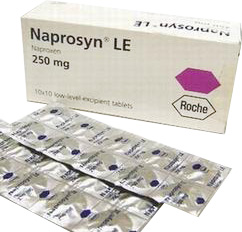Medication Overview
Naprosyn, generically known as naproxen, is a non-steroidal anti-inflammatory drug (NSAID) commonly used to reduce inflammation and pain in musculoskeletal conditions. Its chemical formula is C14H14O3, and it acts by inhibiting cyclooxygenase (COX) enzymes, thereby decreasing prostaglandin synthesis.
Pharmacokinetics and Distribution
After oral administration, Naprosyn is rapidly absorbed, reaching peak plasma concentrations within 1 to 2 hours. It exhibits a high plasma protein binding rate of approximately 99%, primarily to albumin. The drug is metabolized in the liver and excreted predominantly in urine, with a half-life of 12 to 17 hours.
Approved Indications
Naprosyn is indicated for treating conditions such as rheumatoid arthritis, osteoarthritis, ankylosing spondylitis, and acute gout exacerbations. It is also prescribed for managing mild to moderate musculoskeletal pain, including tendinitis, bursitis, and primary dysmenorrhea. Its efficacy extends to temporary relief from headache, dental pain, and minor injuries.
Dosage Information
The typical adult dosage for Naprosyn in pain management is 250mg to 500mg twice daily. Maintenance therapy for chronic conditions such as arthritis may vary, often requiring adjustments based on therapeutic response and tolerability. Physicians typically recommend the lowest effective dose to mitigate potential adverse effects.
Administration Guidelines
Naprosyn should ideally be administered with or after food to minimize gastrointestinal discomfort. Tablets should be swallowed whole with a sufficient amount of water, and patients are advised against crushing or chewing the medication to ensure optimal absorption. Consistent intervals between dosages help maintain its therapeutic effect.
Drug Mechanism of Action
The primary mechanism of Naprosyn involves reversible inhibition of cyclooxygenase-1 (COX-1) and cyclooxygenase-2 (COX-2) enzymes, which play a significant role in the synthesis of prostaglandins and thromboxanes. By diminishing these pathways, Naprosyn alleviates inflammation, pain, and fever.
Drug Interactions
Naprosyn may interact with anticoagulants, such as warfarin, increasing the risk of bleeding. Concurrent use with other NSAIDs or corticosteroids may elevate the risk of gastrointestinal ulceration. Co-administration with ACE inhibitors or diuretics can potentially impair renal function.
Side Effects Profile
Common side effects include gastrointestinal disturbances, such as nausea and heartburn. Central nervous system effects may include dizziness and headache. Dermatological reactions, such as rash or pruritus, may also occur. Renal function should be regularly monitored due to nephrotoxic potential, especially in prolonged use.
Monitoring Parameters
Regular monitoring of complete blood count and liver and kidney function tests is recommended for patients on long-term Naprosyn therapy. Blood pressure should also be periodically checked, as NSAIDs can contribute to hypertension. Be vigilant for signs of gastrointestinal bleeding, especially in elderly patients.
Contraindications List
Naprosyn is contraindicated in patients with known hypersensitivity to naproxen or any excipients in the formulation. Patients with severe hepatic impairment or active gastrointestinal bleeding should avoid its use. Naprosyn is also contraindicated in individuals with a history of aspirin or NSAID-exacerbated respiratory disease.
Special Population Considerations
Pediatric use is not recommended for children under 2 years, and dosing in children above this age must be carefully calculated based on weight and specific medical needs. Naprosyn should be used cautiously in elderly patients due to increased susceptibility to renal impairment and gastric complications.
Pregnancy and Lactation
Naprosyn should be avoided during the third trimester of pregnancy due to potential risks of closure of the ductus arteriosus in the fetus. If administered during breastfeeding, it is advised with caution, as naproxen is excreted in breast milk in small amounts.
Storage Requirements
Naprosyn should be stored in a cool, dry place away from direct sunlight and moisture. Keep the medication out of reach of children to prevent accidental ingestion. The ideal storage temperature is generally below 30°C (86°F).
Pharmacogenomic Insights
Genetic polymorphisms can impact Naprosyn metabolism, with variants in the CYP2C9 gene potentially affecting its clearance. Physicians may consider genotyping in cases of altered drug metabolism to tailor therapy and dosing for optimal efficacy and safety.








Reviews
There are no reviews yet.